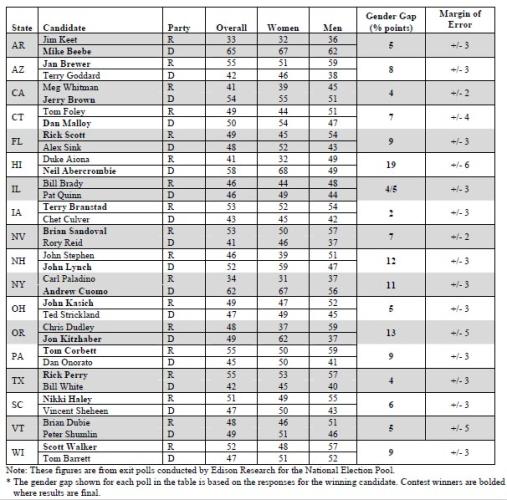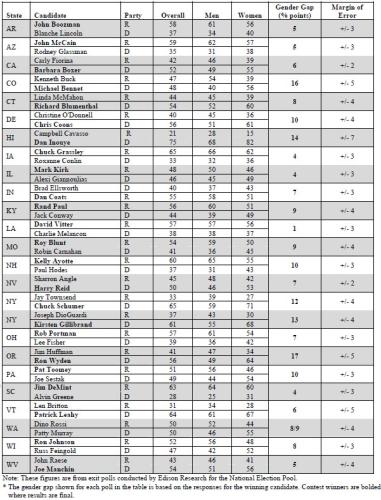Contact: Daniel De Simone; 760.703.0948
Gender gaps in voting were evident in almost all 2010 U.S. Senate and gubernatorial races where exit polls were conducted by Edison Research, according to an analysis by the Center for American Women and Politics (CAWP), a unit of the Eagleton Institute of Politics at Rutgers University. The gender gap – a measurable difference in the proportions of women and men who voted for the winning candidate – was at least as evident in 2010, a year of substantial Republican gains, as it was in 2008, a year when Democrats were elected in large numbers.
In each race where a gender gap was evident, women were more likely than men to support the Democratic candidate, and less likely to support the Republican. Gender gaps of 4 to 19 percentage points were evident in 17 of the 18 gubernatorial races where exit polls were conducted. Similarly, among the 26 U.S. Senate races with exit polls, gender gaps of 4 to 17 percentage points were evident in 25.
Susan J. Carroll, senior scholar at CAWP, observed, "The gender gap is certainly alive and well. In fact, it was more widespread in this election than in any other. Typically, we see gender gaps in about two-thirds of all statewide races. This year we saw gender gaps in all but a couple of contests."
Women and men expressed preferences for different candidates in four key U.S. Senate races:
- In Colorado, women preferred the winner, Democrat Michael Bennet, over Republican Ken Buck by a margin of 56% to 39%, while men opted for Buck (54% to 40%).
- In Pennsylvania, women preferred Democrat Joe Sestak to Republican Pat Toomey by a margin of 54% to 46% while men preferred the victorious Toomey to Sestak (56% to 44%).
- In Wisconsin, women chose Russ Feingold over Ron Johnson (52% to 48%) while men strongly supported the winning candidate Johnson over Feingold (56% to 42%).
Similarly, in Illinois, women preferred Democrat Alexi Giannoulias to Republican Mark Kirk (49% to 46%) while men preferred the winner Kirk to Giannoulias (50% to 45%).
Gender gaps in voting were evident in almost all 2010 U.S. Senate and gubernatorial races where exit polls were conducted by Edison Research, according to an analysis by the Center for American Women and Politics (CAWP), a unit of the Eagleton Institute of Politics at Rutgers University. The gender gap – a measurable difference in the proportions of women and men who voted for the winning candidate – was at least as evident in 2010, a year of substantial Republican gains, as it was in 2008, a year when Democrats were elected in large numbers.
In each race where a gender gap was evident, women were more likely than men to support the Democratic candidate, and less likely to support the Republican. Gender gaps of 4 to 19 percentage points were evident in 17 of the 18 gubernatorial races where exit polls were conducted. Similarly, among the 26 U.S. Senate races with exit polls, gender gaps of 4 to 17 percentage points were evident in 25.
Susan J. Carroll, senior scholar at CAWP, observed, "The gender gap is certainly alive and well. In fact, it was more widespread in this election than in any other. Typically, we see gender gaps in about two-thirds of all statewide races. This year we saw gender gaps in all but a couple of contests."
Women and men expressed preferences for different candidates in four key U.S. Senate races:
- In Colorado, women preferred the winner, Democrat Michael Bennet, over Republican Ken Buck by a margin of 56% to 39%, while men opted for Buck (54% to 40%).
- In Pennsylvania, women preferred Democrat Joe Sestak to Republican Pat Toomey by a margin of 54% to 46% while men preferred the victorious Toomey to Sestak (56% to 44%).
- In Wisconsin, women chose Russ Feingold over Ron Johnson (52% to 48%) while men strongly supported the winning candidate Johnson over Feingold (56% to 42%).
Similarly, in Illinois, women preferred Democrat Alexi Giannoulias to Republican Mark Kirk (49% to 46%) while men preferred the winner Kirk to Giannoulias (50% to 45%).
2010 Exit Poll Gender Data Gubernatorial Races

2010 Exit Poll Gender Data U. S. Senate Contests

Contact: Daniel De Simone; 760.703.0948

